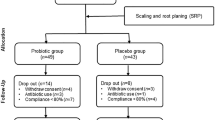Abstract
Bacillus subtilis is an effective probiotic product for prevention of enteric infections both in humans and animals. We hypothesized that a mouth rinse containing Bacillus subtilis should adhere to and colonize part of the oral bacteria on periodontal tissue. The rinsing ability of Extraction 300E (containing Bacillus subtilis: E-300 ) was compared with that of a mouth wash liquid , Neosteline Green (benzethonium chloride; NG) that is commonly used in Japan. Compared with NG rinsing, E-300 rinsing resulted in a marked change in the BANA-score. The mean BANA values (score ± SD) over the course of the study from 0 to 30 days were 1.52 ± 0.51 (p ≤ 0.1) and 0.30 ± 0.47 (p ≤ 0.01) for E-300, and 1.56 ± 0.51 and 0.93 ± 0.68 for NG, respectively. Gingival Index also had improvement, while probing pocket depth and bleeding on probing showed small improvements. Mouth rinsing with E-300 significantly reduced periodontal pathogens compared with NG. These results suggest that Bacillus subtilis is an appropriate mouth rinse for patients with periodontitis.
Similar content being viewed by others
References
Nishimura F, Iwamoto Y, Mineshiba J et al (2003) Periodontal disease and diabetes mellitus: the role of tumor necrosis factor-alpha in a 2-way relationship. J Periodontol 74:97–102
Becker W, Becker BE, Caffesse R et al (2001) A longitudinal study comparing scaling, osseous surgery, and modified Widman procedures: results after 5 years. J Periodontol 72:1675–1684
van Winkelhoff AJ, Rams TE, Slots J (1996) Systemic antibiotic therapy in periodontics. Periodontol 10:45–78 2000
Slots J, Rams TE (1990) Antibiotics in periodontal therapy: advantages and disadvantages. J Clin Periodontol 17(7(Pt 2)):479–493
Ciancio SG, Lauciello F, Shibly O et al (1995) The effect of an antiseptic mouthrinse on implant maintenance: Plaque and peri-implant gingival tissues. J Periodontol 66:962–965
Christine H, Charles RDH, Naresh C et al (2001) Comparative efficacy of an antiseptic mouthrinse and an antiplaque/antigingivitis dentifrice. J Am Dent Assoc 132:670–675
Charles CH, Mostler KM, Bartels LL et al (2004) Comparative antiplaque and antigingivitis effectiveness of a chlorhexidine and an essential oil mouthrinse: 6-month clinical trial. J Clin Periodontol 31:878–884
Meurman JH (2005) Probiotics: do they have a role in oral medicine and dentistry? Eur J Oral Sci 113:188–196
Newaj-Fyzul A, Adesiyun AA, Mutani A et al (2007) Bacillus subtilis AB1 controls Aeromonas infection in rainbow trout (Oncorhynchus mykiss, Walbaum). J Appl Microbiol 103:1699–1706
Brunt J, Newaj-Fyzul A, Austin B (2007) The development of probiotics for the control of multiple bacterial diseases of rainbow trout, Oncorhynchus mykiss (Walbaum). J Fish Dis 30:573–579
Loe H, Silness J (1963) Periodontal disease in pregnancy.1. Prevalence and severity. Acta Odontologica Scandinavica 21:533–551
Loesche WJ, Bretz WA, Lopatin D et al (1990) Multi-center clinical evaluation of a chairside method for detecting certain periodontopathic bacteria in periodontal disease. J Periodontol 61:189–196
Hong HA, le Duc H, Cutting SM (2005) The use of bacterial spore formers as probiotics. FEMS Microbiol Rev 29:813–835
Wang J, Fung DY (1996) Alkaline-fermented foods: a review with emphasis on pidan fermentation. Crit Rev Microbiol 22:101–138
de Jong N, Ocké MC, Branderhorst HA et al (2003) Demographic and lifestyle characteristics of functional food consumers and dietary supplement users. Br J Nutr 89:273–281
Meurman JH, Stamatova I (2007) Probiotics: contributions to oral health. Oral Dis 13:443–451
Hatakka K, Ahola AJ, Yli-Knuuttila H et al (2007) Probiotics reduce the prevalence of oral candida in the elderly–a randomized controlled trial. J Dent Res 86:125–130
Krasse P, Carlsson B, Dahl C et al (2006) Decreased gum bleeding and reduced gingivitis by the probiotic Lactobacillus reuteri. Swed Dent J 30:55–60
Author information
Authors and Affiliations
Corresponding author
Rights and permissions
About this article
Cite this article
Tsubura, S., Mizunuma, H., Ishikawa, S. et al. The effect of Bacillus subtilis mouth rinsing in patients with periodontitis. Eur J Clin Microbiol Infect Dis 28, 1353–1356 (2009). https://doi.org/10.1007/s10096-009-0790-9
Received:
Accepted:
Published:
Issue Date:
DOI: https://doi.org/10.1007/s10096-009-0790-9




